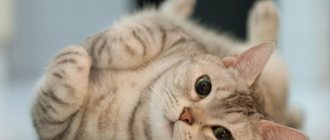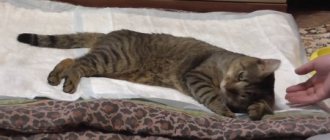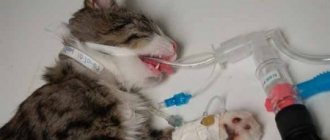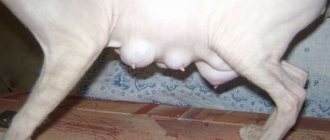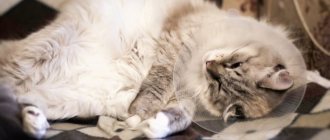Estrus (estrus) is a natural process for a cat’s body, indicating puberty of the pet. It is from the moment of the first estrus that a cat can become pregnant and bear kittens. But the owner who is not breeding the breed is more concerned about the external symptoms of estrus: changes in behavior, nutrition and, of course, loud screams at night.
In this article we will talk about the puberty of cats and all the pitfalls of this period that owners need to prepare for. And also how to alleviate the cat’s condition before the end of sexual heat.
Brief information about cat heat
| When does the first heat start? | Depending on the breed and weight of the kitten, estrus may begin between 6 and 12 months of age. |
| How long does a cat's heat last? | 5 – 14 days. |
| Periodicity | The beginning of the first heat of the year is the beginning of spring, the end is mid-autumn. Periods between heats:
After giving birth, your cat will go into heat within 3-5 months. |
| Common symptoms |
|
| When can you breed a cat? | A cat can only be bred for 2-3 heats, since during the first estrus the pet’s body is rarely ready to bear healthy offspring. |
| Does estrus go away after sterilization? | If a cat has had her ovaries removed (oophorectomy) or her ovaries and uterus (ovariohysterectomy), the cat will no longer be in heat. But if the uterus was removed while preserving the ovaries or the fallopian tubes were pulled, then all signs of sexual desire will remain. |
A sterilized cat asks for a cat: 4 reasons
There are the following causes of estrus in sterilized females:
- Incomplete removal of epididymal tissue. Occurs when an unremoved piece of ovarian or epididymal tissue remains, which is capable of regenerating and partially replacing the internal secretion organ. Estrus occurs as usual, but pregnancy does not occur and the pet will not be able to bring kittens. Repeated surgery, as a rule, does not solve the problem. Not every veterinarian is able to find the criminal piece of tissue, and repeated anesthesia will harm the cat’s health. However, the chance of achieving a positive result increases if the uterus and surrounding tissue are removed.
- Development of the reminant ovary. After the removal of the reproductive organs, the pituitary gland or adrenal glands begin to produce sex hormones. Statistics show that one out of seven castrated cats can retain the ability to secrete estrogen.
- Congenital anomaly. Cells of the ovarian appendages take root in other organs.
- Development of a hormone-like tumor. The neoplasm has the ability to secrete estrogens. Pathology is observed in cats that were castrated in adulthood.
Be sure to read:
How long to wear a blanket after sterilizing a cat, after how many days to remove it
What is estrus
Estrus (the medical term is estrus) is the physiological and behavioral changes caused by hormonal changes by the age of 6-8 months. By this period, follicles have formed in the ovaries, and the female is ready for conception and gestation.
However, such an early pregnancy is usually difficult, the kittens are born weakened, and the cat takes a long time to recover after giving birth. Therefore, it is better to wait until 1.5 years of age before the first mating. By this time, the cat will get stronger and give birth to healthy offspring.
Some females may go into heat at 6 months, but puberty usually occurs between 8 and 10 months of age. You should worry about a cat’s absence of heat only after 18 months of life. In this case, the cat needs to be shown to a veterinarian, he will prescribe a vitamin complex, diet or complex treatment.
Reference! The first heat may occur without noticeable symptoms. Symptoms intensify by the 2nd year of life. Older cats go into heat without obvious symptoms.
What can be done?
Surgical correction
The quality of the operation can be assessed during an ultrasound examination.
If a neutered cat returns to estrus, you should visit a veterinary clinic to find out the cause. First, we must exclude the most common option—poor surgical treatment. To do this, they will offer to conduct an ultrasound of the pelvic organs, laboratory examination for estrogens, progesterone, luteinizing hormone, anti-Mullerian hormones, tests with gonadotropins, colpocytology (vaginal smear). If the diagnosis is confirmed, repeated surgery is indicated.
To eliminate retained ovary syndrome, a laparotomy with wide access to the abdominal cavity is performed, rather than laparoscopy, when the view is difficult due to a small incision.
Medicines
In the case of inertial estrus, it is sometimes suggested to wait, to give time for the body to independently eliminate circulating sex hormones. If the animal is clearly suffering, drug treatment is available in the form of synthetic hormones (Covinan, Perlutex) or their analogues (Sex Barrier), injectable forms of drugs that act for 3-6 months are possible, for example, Depopromone. However, it is important to familiarize yourself with the side effects of treatment, choose the correct dosage and timing of administration, so consulting a veterinarian should not be neglected.
At what age can it start?
The onset of the first heat depends on many factors:
| Factors influencing the timing of the first estrus | Factor influence |
| Cat breed | Long-haired breeds grow and mature somewhat later. These include large cat breeds:
Individuals of medium proportions mature much earlier:
|
| Birth season | Females born in summer mature faster than females born in the winter months. Therefore, you should not be surprised if the first heat begins at 5-7 months. |
| Heredity | Early puberty in parents is passed on to offspring. |
| Balanced diet and good care | A balanced diet rich in minerals, amino acids and vitamins, plus proper care for the animal, promotes proper development and normal puberty. |
| Illumination | If the animal lives in a very dark room, sexual activity occurs less frequently. |
| Presence of other cats in the house | When surrounded by other individuals, sexual activity occurs earlier. |
Maine Coon cats
Puberty of this type of pet occurs at 9–16 months. As with any other breed, the frequency and duration of estrus in a Maine Coon cat depends on the personal development of the animal. In pets that live in comfortable conditions, estrus can occur throughout the year. During this period, the Maine Coon loses its appetite and drinks a lot, and its growth temporarily stops. When pregnancy occurs, the female immediately calms down, otherwise she continues to be nervous for another 7–11 days. In the future, Maine Coons come into heat after one and a half or two months, although a longer break between them is possible.
It is very dangerous if estrus recurs after two to three weeks or continues for two to three months. In the first case, it is necessary to urgently contact a veterinarian, and in the second, breed or sterilize the animal. You should never stop or delay estrus using hormonal drugs - this is dangerous for the health of the animal.
Symptoms
You can determine when your pet is in heat by the following symptoms:
- The animal's behavior changes . The cat becomes affectionate, rubs against pieces of furniture or the owner’s legs, and purrs. Or, on the contrary, the pet becomes very aggressive, and at any slightest contact with a person, it can scratch or bite.
- These days, your pet can roll on the floor, squirm or meow pitifully, and make strange uterine sounds, as if she is experiencing severe pain. But this, of course, is not true. This behavior in a cat can be observed not only during the day, but also at night.
- The female urinates more often , and she goes to the litter box more and more often.
- Appetite changes. The animal may partially or completely refuse to eat. Try to feed your cat small portions. And remember: clean, fresh water should always be present in the animal’s bowl.
- Your pet's genitals become slightly swollen. Transparent discharge appears from them . Therefore, the cat begins to lick its genitals frequently.
- The gait becomes strange and unnatural . The animal moves on half-bent legs.
- When stroking the back, the cat falls on its front paws, puts its tail to the side, and tramples with its hind paws.
- The pet can leave marks . This brings a lot of trouble to the owners. But you shouldn’t scold her for this, otherwise you will only make the situation worse.
Attention! If the animal is exhausted or, on the contrary, is obese, then the process of sexual activity can proceed completely unnoticed.
During this period, the cat may try to escape outside to the cats through a slightly open window or door, so watch your pet more closely.
Drugs
There are many special medications aimed at easing the condition of cats during estrus. All of them are divided into 2 large groups: non-hormonal (herbal-based medicines that have a calming effect) and hormone-based medicines.
Medications for cats during estrus are available in the form of drops, tablets and injection solutions.
Sedative herbal preparations are less effective than hormonal ones, but in recommended doses they are guaranteed not to harm the pet, so their use is preferable. Such means include:
- “Stop Stress” - drops and tablets containing herbal extracts that have a calming effect, as well as the substance phenibut, which helps cope with anxiety and anxiety.
- “Cat Bayun” is a remedy that contains a whole complex of herbs with a sedative effect.
- Fitex drops are a herbal preparation used in cats that are in a stressful situation, including during estrus.
- Relax Plus tablets also have a positive effect during estrus due to the extracts of valerian, mint and motherwort contained in the composition.
Stop stress Non-
hormonal means of correcting the behavior of cats during estrus also include Feliway, a drug based on pheromones. It has 3 release forms: spray, diffuser and special collar.
Unlike the drugs listed above, hormone-based drugs should only be prescribed by a specialist. The veterinarian recommends a specific drug, dosage and monitors how the cat tolerates the treatment.
Attention! It should be understood that these drugs can change the hormonal levels of the pet’s body, have side effects and require proper dosing. Therefore, the decision to use such methods must be approached with full responsibility.
Examples of popular hormonal agents used for estrus in cats:
- “Sex barrier” - pills that interrupt estrus due to the action of the gestagen and estrogen they contain.
- Stop-Intim drops are also prescribed to regulate sexual desire. Different versions of these drops are produced: both for cats and for male cats.
- "Gestrenol" - tablets and drops that interrupt and delay estrus by suppressing the formation of sex hormones.
- “Contrasex” is another hormonal drug based on artificial estrogen that eliminates estrus.
There are also hormone-based drugs that are available by injection, such as Covinan and Depo-Promon. One injection of such a solution can lead to the absence of estrus in the animal for 6-12 months. However, these drugs have a big disadvantage - their regular use can lead to the development of cancerous tumors.
How long does heat last and how often?
A female who has previously given birth occurs in heat once every 2-3 months. And if the cat has not yet had offspring, then the heat will be once a month or even every 2 weeks.
This process lasts 5-14 days. It all depends on the individual characteristics of the animal’s body.
If the pet has already become pregnant and given birth, then estrus occurs no earlier than after 3-5 months.
The opinion that a cat must give birth at least once to be healthy is wrong.
Sphynx cats
In a Sphynx cat, sexual maturity occurs at six to seven months. At this time, she begins her first heat. The animal begins to scream loudly and roll on the floor. Her gait becomes completely different, her character changes. Some become affectionate and kind, while others become angry and aggressive. The duration of estrus in a Sphynx cat lasts on average 5–8 days, and sometimes up to two weeks. The frequency of estrus is strictly individual, as is its duration. For some it occurs once a month, for others – twice. The irregularity of estrus is associated with the lack of fertilization of the female.
The greatest sexual activity among sphinxes occurs at the end of winter and beginning of spring. The first pregnancy can occur at reproductive age from one to one and a half years, not earlier than the third heat. If the owner does not plan the birth of offspring, then after the end of the estrus period, sterilization is carried out.
Stages of estrus
The duration of the stages is individual for each cat. Signs may overlap each other. And therefore, it is sometimes difficult to determine the timing of mating with a cat.
Estrus is divided into four stages:
- Proestrus is the very first stage. It lasts from 1 to 5 days. At this time, the animal begins to require increased attention. Colorless discharge appears from the vagina. But, during this stage, the female is not yet ready for mating and fertilization, and therefore does not allow the male to approach her.
- Estrus is the second stage of estrus. It lasts 6-7 days. It all depends on the characteristics of your pet’s body. During the period of estrus, the animal meows loudly day and night, frightening its owners. When stroking, it raises the back of the body and moves the tail to the side. At this time, days 3-5 are considered the most favorable days for fertilization.
- Metestrus is the third stage of estrus, during which all signs of sexual activity begin to disappear. The cat is no longer interested in the cat. She only shows aggression towards him. This lasts for 7-8 days. It is possible that fertilization has occurred. At this time, embryos begin to develop. If this does not happen, then in 2-3 weeks the heat will appear again.
- Anestrus is the final stage of estrus. At this time, the pet becomes calm, all signs of sexual activity disappear.
Features of the first heat
Established conditions for breeding purebred cats prescribe breeding mature animals no earlier than the first year of life. It is believed that during this period the formation is completed and there is a physiological opportunity for the birth of offspring.
For the first time this process usually begins at the age of 10-11 months, it is then that a female can be brought together with a male.
In fact, it all depends on the breed, temperament, health status and other individual characteristics. In some pets, the first discharge appears at 7-8 months, but knitting at this age is not recommended, the body is not yet ready for childbearing.
Often there is a problem of early estrus in a purebred cat, on which the breeders had great hopes. In this case, doctors advise removing the pet from breeding, since the problem can be inherited. In this case, veterinarians insist that the cat be sterilized.
However, if the owners of the animal are categorically against it, it is necessary to begin treatment with medications as early as possible in order to improve the hormonal balance and the functioning of all body systems.
Deviations from the norm
Prolonged heat
It happens that a pet is in heat for more than 2 weeks. This is called prolonged heat. This means an increase in the stages of estrus. There is a protracted proestrus, a protracted estrus and a protracted diestrus.
Symptoms of prolonged proestrus:
- The cat won't let the cat near.
- Discharge from the genitals continues for more than two weeks.
Symptoms of prolonged estrus:
- Estrus lasts more than 2-3 weeks, but fertilization does not occur.
Symptoms of prolonged diestrus:
- Mucous discharge from the female genitals does not stop for 21 days.
Anaphrodisia
Another deviation is the complete absence of estrus symptoms (anaphrodisia).
Symptoms:
- Lengthening of the intervals between estrus in a mature cat or its complete absence.
- Delayed puberty in a young individual.
If any of these deviations occur, be sure to show the cat to a specialist. He will prescribe competent treatment.
False pregnancy
It happens that fertilization does not occur. The female develops a so-called false pregnancy. This is a psychological condition during which the cat experiences all the signs of a non-existent pregnancy. The cause of the disease may lie in stressful situations, mating with an unproductive male, or a breed predisposition, for example, in sphinxes.
This condition lasts for 1-3 weeks. It is difficult to distinguish it from ordinary pregnancy.
Symptoms of false pregnancy:
- abdominal enlargement;
- swelling of the mammary glands;
- secretion of milk;
- increased appetite;
- constant thirst.
The pet's behavior also changes. She is looking for a secluded dark place, trying to arrange a bed for herself.
Also, your pet may begin to carry various soft toys in her teeth, mistaking them for her offspring.
This condition is dangerous because the cat can develop purulent mastitis.
Only a veterinarian can confirm whether it is a false pregnancy or a real one after examination. He will prescribe sedatives to stop lactation.
Empty heat
This is an estrus that did not result in the pet becoming pregnant. It can lead to many complications: ovarian cysts, inflammation and even cancer. Therefore, if you do not plan to mate your cat, it is best to have her spayed. You can read about all the nuances of this operation in our article on sterilization of cats.
Bloody issues
It is worth remembering that cats, unlike dogs, do not have bloody discharge. If you notice bloody discharge in a female, then this is a serious cause for concern and an urgent visit to the veterinary clinic.
The most likely causes of postoperative estrus:
- Gradual attenuation of hormonal levels . After the operation, sex hormones continue to circulate in the animal’s blood for some time. Usually everything ends after 2-8 weeks, but there are cases of longer attenuation. This is one reason why surgery should not be performed during heat.
- Syndrome of preserved ovarian tissue (ovarioreminant syndrome). Any tissue in the body has the function of self-reproduction through division. At least one randomly remaining ovarian cell (not to mention a piece of tissue) is enough for it to grow over time into a section of ovarian tissue with a characteristic structure and the ability to secrete sex hormones (or even mature eggs).
How to relieve a cat's condition
There are several options to alleviate the psychological and physical condition of the female during estrus:
- Give your furry pet more attention, pet her, hug her. All this will help relieve stress and calm her down a little.
- Distract with a new toy . Active games will help relieve your cat's nervous condition.
- Bathe the animal . Just do this in warm water and in a draft-free room. After bathing, the pet will begin to lick itself and clean itself up. This will give you several hours of long-awaited silence.
- Mating with a cat . If the cat is mature and healthy, and you are ready for offspring to appear in the house.
- Sedatives reduce sexual activity and help reduce stress.
- Hormonal drugs . You should not get carried away with these drugs, as they can cause great harm to your cat’s health.
- Sterilization . A suitable option for those owners who do not need kittens. This will not harm your pet and will help solve many problems that may arise.
Remember that the cat needs your love, affection and care during this difficult period. Therefore, you should not scold her for marks left on the floor, for constant “concerts”, for obnoxious behavior. You cannot lock your mustachioed pet in a cold, dark room. Try to be more patient, show more affection and attention to your ward.
How to help a cat during heat?
It must be emphasized that the preferred method of relieving a cat of the discomfort associated with the need to reproduce is sterilization. Of course, the operation is appropriate only when the owner does not plan to breed kittens. Sterilized cats are generally calmer, usually live longer than unsterilized ones, and they are much less likely to develop tumors and other diseases of the genital organs.
If for some reason the cat is not sterilized, then the period of estrus without satisfying sexual needs is not easy for her. To help his pet, the owner can use the following methods:
- Meeting with a cat. There is no better way to calm a cat during heat than by breeding. Naturally, this method is only suitable for those owners who are ready to have kittens.
Attention! It must be remembered that too frequent pregnancies and childbirth deplete the cat’s body, so this process requires control from the owner. Optimal intervals between pregnancies should be observed; mating should not be done at every estrus.
- Increased attention from the owner. During the period of heat, a cat needs the affection and love of its owner more than ever. Frequent stroking helps to relax the pet, but you should not stimulate the lower back, this can lead to the opposite effect and the cat will become even more restless.
- Active games. You need to play with your pet more. During the game, the animal gets tired and is distracted from its condition. You can buy your cat a new toy to interest her and redirect her attention to the game.
- Warm. Insulating your pet's house can also help her calm down. You can use a heating pad wrapped in a towel, placing it under your cat's bed or in the area where she usually rests.
- Bathing. Another way to distract an animal is to bathe it. Warm water can also relax your cat, and the subsequent licking will keep her occupied for a while. This method is suitable for those pets who calmly respond to bathing, otherwise this process will become additional stress and will not calm down, but will upset the cat even more. It should also be remembered that too frequent bathing can damage the protective layer of the skin, so water treatments are good in moderation.
Bathing
- Providing your pet with isolation and peace. You can allocate a separate room for your pet and provide it with everything it needs: food, enough water, a place to sleep. In the evening, you don’t have to turn on the light in the room: in the dark, cats are less worried during estrus than in the presence of bright lighting. This method is not suitable for everyone, because some cats during this period become calmer during isolation, while others, on the contrary, need the presence of the owner.
- Folk remedies. There are safe and effective folk methods that help alleviate the condition of a cat during estrus. Good results are shown by the use of catnip, as well as the use of chamomile or linden decoctions.
Veterinarian advice
The duration of a cat's heat usually lasts about a week. During this period, she behaves inappropriately: she screams loudly, rolls on the floor, pesters the owner, considering him a sexual partner. To alleviate the animal’s condition, veterinarians advise:
- Bathe your pet. While she licks the skin in the house, silence is established, and her stress is relieved.
- Organize active games. Exercising with a new interesting toy, climbing and jumping will distract the animal from nervousness for a while.
- Feeding in small portions improves general condition and digestion.
- Providing more attention gives the animal confidence and relieves nervousness. You need to talk to the cat kindly, stroke her head and belly, but do not touch her back and croup.
- Reduce lighting - this will help the estrus stop faster. You can close the curtains in the room.
- Use sedatives to calm, but not affect the cessation of estrus: “Stop Stress”, “Cat Bayun”.
In addition, sterilization is allowed, but you just have to wait until the estrus ends. Doing this procedure during estrus is very dangerous for the health of the animal.
